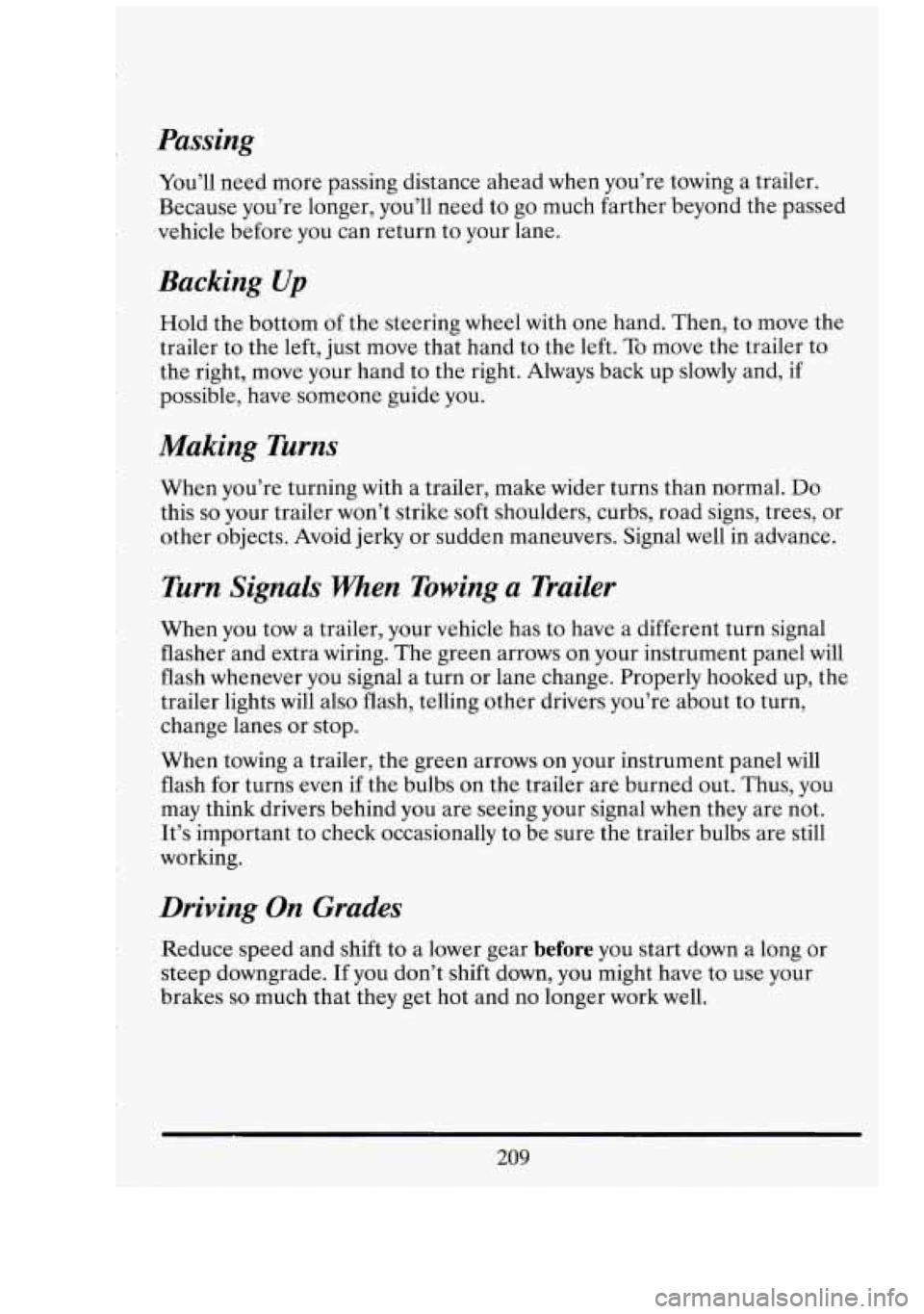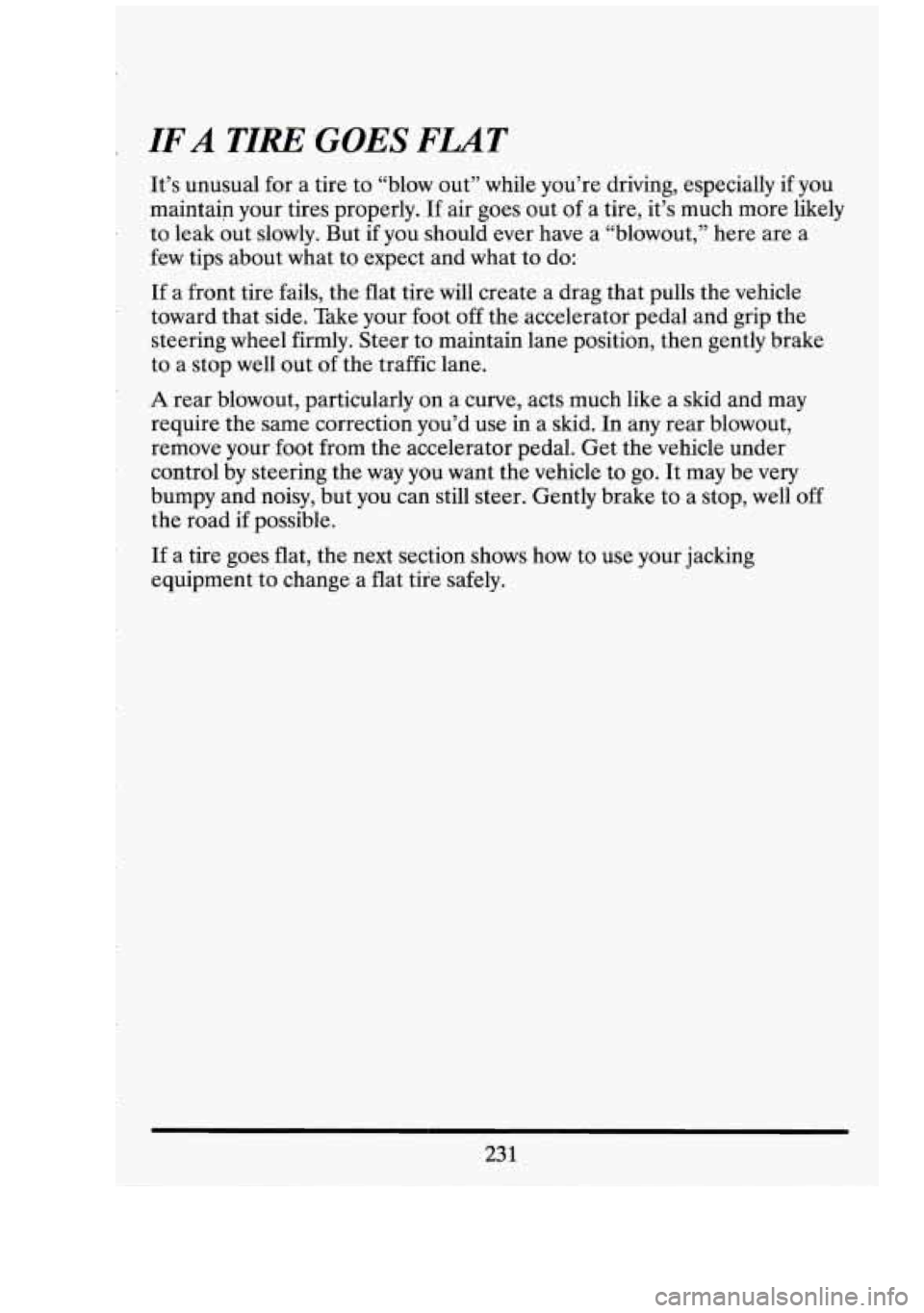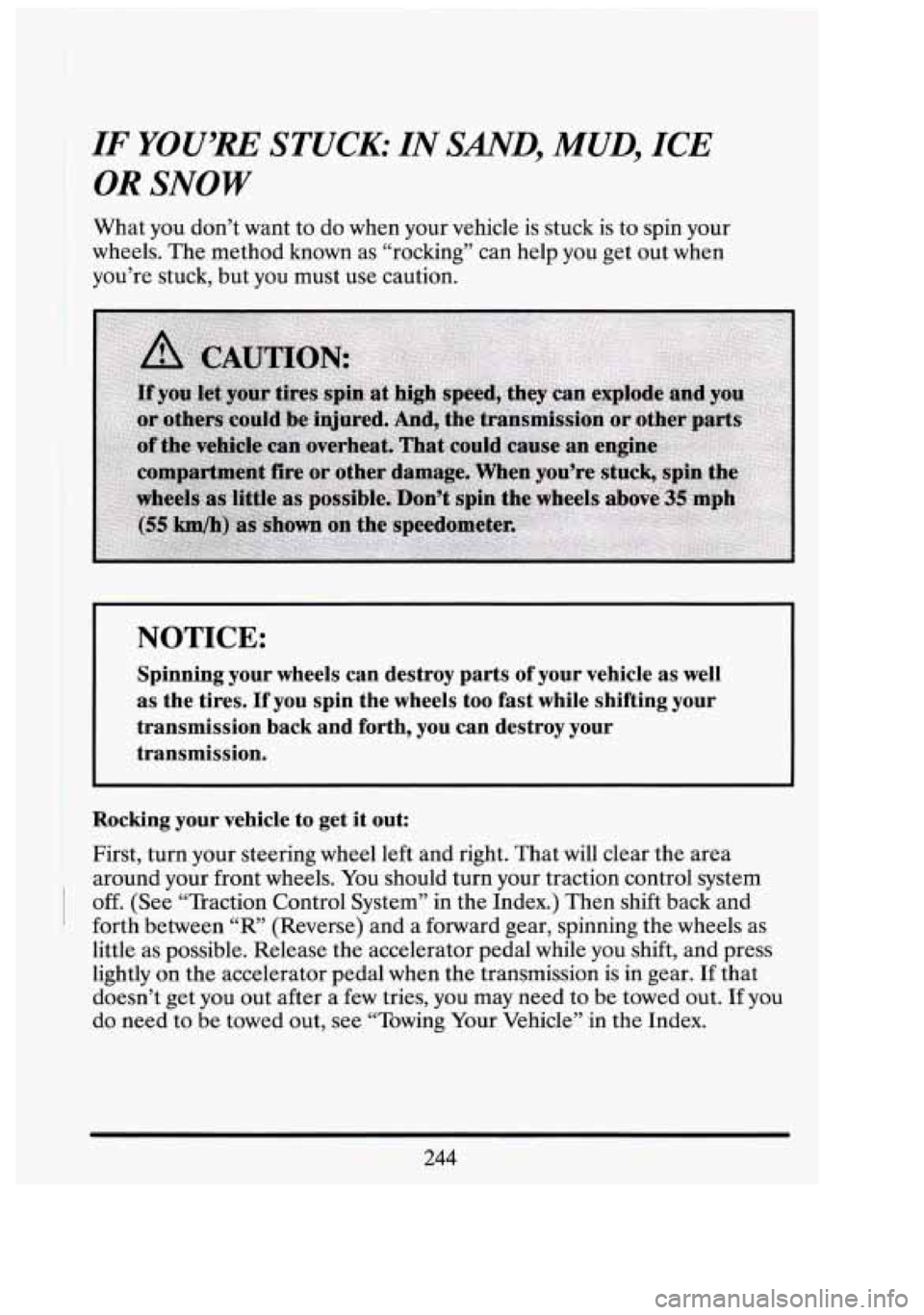Page 222 of 398

Passing
You’ll need more passing distance ahead when you’re towing a trailer.
Because you’re longer, you’ll need to go much farther beyond the passed
vehicle before you can return to your lane.
Backing Up
Hold the bottom of the steering wheel with one hand. Then, to move the
trailer to the left, just move that hand to the left.
To move the trailer to
the right, move your hand to the right. Always back up slowly and, if
possible, have someone guide you.
Making Turns
When you’re turning with a trailer, make wider turns than normal. Do
this so your trailer won’t strike soft shoulders, curbs, road signs, trees, or
other objects. Avoid jerky or sudden maneuvers. Signal well in advance.
Turn Signals When Towing a Trailer
When you tow a trailer, your vehicle has to have a different turn signal
flasher and extra wiring. The green arrows on your instrument panel will
flash whenever you signal a turn or lane change. Properly hooked up, the
trailer lights will also flash, telling other drivers you’re about to turn,
change lanes or stop.
When towing a trailer, the green arrows on your instrument panel will
flash for turns even if the bulbs on the trailer are burned out. Thus, you
may think drivers behind you are seeing your signal when they are not.
It’s important to check occasionally to be sure the trailer bulbs are still
working.
Driving On Grades
Reduce speed and shift to a lower gear before you start down a long or
steep downgrade.
If you don’t shift down, you might have to use your
brakes
so much that they get hot and no longer work well.
209
Page 233 of 398
When the towing service arrives, let the tow operator know that this
manual contains detailed towing instructions and illustrations. The
operator may want to see them.
When your vehicle is being towed, have the ignition
key off. The steering
wheel should be clamped in a straight-ahead position, with a clamping
device designed for towing service.
Do not use the vehicle's steering
column lock
for this. The transmission should be in Neutral and the
parking brake released.
Don't have your vehicle towed on the rear wheels, unless you must. If the
vehicle must be towed
on the rear wheels, don't go more than 35 mph (56
km/h) or farther than 50 des (80 km) or your transmission will be damaged.
:!I
u 'I
f
220
Page 244 of 398

r IF A TIREGOES FLAT
It’s unusual for a tire to “blow out” while you’re driving, especially if you
maintain your tires properly. If air goes out of a tire, it’s much more likely
to leak out slowly. But
if you should ever have a “blowout,” here are a
few tips about what to expect and what to do:
If a front tire fails, the flat tire will create a drag that pulls the vehicle
toward that side. Take your foot off the accelerator pedal and grip the
steering wheel firmly. Steer to maintain lane position, then gently brake
to a stop well out of the traffic lane.
A rear blowout, particularly on a curve, acts much like a skid and may
require the same correction you’d use in a skid. In any rear blowout,
remove your foot from the accelerator pedal. Get the vehicle under
control by steering the way you want the vehicle to
go. It may be very
bumpy and noisy, but you can still steer. Gently brake to a stop, well off
the road
if possible.
If a tire goes flat, the next section shows how to use your jacking
equipment to change a flat tire safely.
231
Page 257 of 398

I-
IF YOU’RE STUCK: IN SAND, MUD, ICE
OR SNOW
What you don’t want to do when your vehicle is stuck is to spin your
wheels. The method known as “rocking” can help you get out when
you’re stuck, but you must use caution.
I I NOTICE:
Spinning your wheels can destroy parts of your vehicle as well
as the tires. If you spin the wheels too fast while shifting your
transmission back and forth, you can destroy your
transmission.
Rocking your vehicle to get it out:
First, turn your steering wheel left and right. That will clear the area
around your front wheels. You should turn your traction control system
off. (See “Traction Control System”
in the Index.) Then shift back and ’ forth between “R’ (Reverse) and a forward gear, spinning the wheels as
little as possible. Release the accelerator pedal while you shift, and press
lightly on the accelerator pedal when the transmission is in gear.
If that
doesn’t get you out after a few tries, you may need to be towed out.
If you
do need to be towed out, see “Towing Your Vehicle” in the Index.
244
D/
Page 283 of 398
POWER STEERING FLUID
I
How To Check Power Steering Fluid
Unscrew the cap and wipe the dipstick with a clean rag. Replace the cap
and completely tighten it. Then remove the cap again and look at the
fluid level on the dipstick.
When the engine compartment is hot, the level should be at the
“H” mark.
When the engine compartment is cool, the level should be at the
“C” mark.
Page 284 of 398
What to Add
Refer to the Maintenance Schedule to determine what kind of fluid to
use. See “Recommended Fluids and Lubricants” in the Index.
I
NOTICE:
When adding power steering fluid or making a complete fluid
change, always use the proper fluid. Failure to use the proper
fluid can cause leaks and damage hoses and seals.
WINDSHIELD WASHER FLUID
b Add
Open the cap labeled
“WASHER FLUID
ONLY.” Add washer
fluid until the bottle is
full.
271
Page 335 of 398

FLUID CAPACITIES
Auto Trans (4L60) Pan Removal ................... 5 qts. (4.7 L)
Auto Trans (4L60) Overhaul (245mm Torque Conv.)
. . 8 qts. (7.9 L)
Auto Trans (4L60) Overhaul (298mm Torque Conv.) 11 qts. (10.6 L)
Engine Oil
& Filter Change ..................... 5.0 qts. (4.7 L)
Engine Cooling ............................. 17.6 qts. (16.6 L)
Fuel Tank
................................ .23 gallons (87.4 L)
Power Steering
.................................. 2 qts. (1.9 L)
Rear Axle .................................... 4.3 pts. (2.0 L)
Washer Solvent.
............................... 2.5 qts. (2.4 L)
TIGHTEN TORQUE
Spark Plug ................................ 15 Nom (11 lb. ft.)
Oil Filter
.................................. 19 Nom (14 lb. ft.)
Wheel Lug Nut.
.......................... 135 Nom (100 lb. ft.)
Rear Axle Filler Plug
........................ 35 Nom (26 lb. ft.)
Oil
Pan Drain Plug
.......................... 41 Nom (30 lb. ft.)
VEHICLE DIMENSIONS
Shipping Weight .......................... 4410 Ibs. (1999.9 kg)
Wheel Base
............................... 121.5 in (3085 mm)
Length
.................................... .224 in (5696 mm)
Height
..................................... .57 in (145 1 mm)
Width
...................................... .77 in (1952 mm)
Front Tread
................................ 61.7 in (1568 mm)
Rear Tread
................................ 60.7 in (1542 mm)
ti
t
-1
I
322
Page 380 of 398

.
.
. FLEETWOOD INDEX
.
.
.
.
.
c-
.
.
A
Acc (Ignition Key Position) ........................... 86
Adding
Brake Fluid
..................................... 274
Electrical Equipment ......................... 152. 311
Engine Coolant ............................. 227. 266
Engineoil ...................................... 256
Power Steering Fluid ............................. 271
Transmission Fluid ............................... 265
Additives. Engine Oil ............................... 260
Adjustment. Brake ................................. 178
Adult Safety Belt Usage .............................. 20
Air Bags ........................................... 30
Aircleaner ....................................... 261
Air Cleaner & PCV Filter Replace ......... See Maint . Book
Air Conditioner
.................................... 147
Air Outlets ........................................ 146
Airsystem ........................................ 146
Alarm. How To Turn Off Theft ........................ 82
Alcohol. Driving Under The Influence Of .............. 167
Alcohol& Gasoline ................................. 247
AMAX .......................................... 153
AM Radio Reception ............................... 152
AM Stereo Radio Reception ......................... 153
Antenna. Cleaning Radio ............................ 164
Antifreeze ........................................ 266
Antilock Brakes .................................... 173
Antilock Brake System Warning Light ................. 133
Anti-Theft Tips ..................................... 81
Appearance ....................................... 300
Appearance Care. Service and ........................ 245
Arm. Wearing A Safety Belt Under Your ................ 28
Armrest. Storage ................................... 129
Ashtrays .......................................... 126
Assist Handles ..................................... 128
Astroroof ......................................... 125
Audio Systems. Comfort Controls and ................. 146
Automatic Air Conditioning System ................... 147
Automatic Door Locks ............................... 71
Automatic Overdrive ................................ 92
Automatic Transmission .............................. 90
.
1